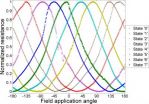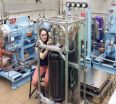(Press-News.org) VIDEO:
In this video, biodesign researcher Krupa Navalkar describes a new diagnostic technique for pinpointing Valley Fever.
Click here for more information.
On July 5, 2011, a massive wall of dust, ("haboob," in Arabic), blanketed Phoenix, Arizona, creating an awesome spectacle, (or stubborn nuisance, depending on your perspective). Dust storms are a common occurrence in the arid desert environments of the American Southwest.
But windborne dust can be a serious health risk, lofting spores of a sometimes-lethal fungus known as Coccidioides. The resulting ailment, known as coccidioidomycosis or valley fever, has been perplexing researchers since it was first described in 1892. It is currently on an alarming ascent in the United States.
Dr. Stephen Albert Johnston, Krupa Navalkar and their colleagues at Arizona State University's Biodesign Institute have been investigating Valley Fever. Navalkar is the lead author of a new study describing a promising strategy known as immunosignaturing, which can provide clinicians with an accurate identification of valley fever, a potentially serious affliction that is often misdiagnosed.
"The incidence of this disease is seemingly low due to non-sensitive diagnostic assays," Navalkar says. As Johnston further notes, "immunosignatures could easily change those false assumptions if made available in the clinical setting."
Navalkar is a researcher in Biodesign's Center for Innovations in Medicine, under the direction of Stephen Albert Johnston, who is also a co-author of the new study.
The group's findings appear in the current issue of the journal ASM Clinical and Vaccine Immunology.
Valley fever is a fungal respiratory infection. It can be acquired when microscopic spores of the soil-dwelling fungus are inhaled. Two forms of the fungus exist, Coccidioides immitis and Coccidioides posadasii. They are endemic to regions of Arizona, New Mexico, California, Nevada, Utah, Texas and northern Mexico.
During extended periods of dryness, the fungal spores remain dormant. With rainfall, the spores or arthroconidia develop elongated filaments, which break off and can be lofted into the air by soil disruption due to farming, construction, earthquakes or dust storms.
Most individuals inhaling Coccidioides particles are assumed to be able to naturally resolve the infection, developing immunity to future spore infections.Often such non-symptomatic individuals are unaware they have been exposed. Others are not so fortunate, however.
In around 40 percent of cases, valley fever causes flu-like symptoms including cough, headache, muscle and joint pain and rash. For reasons still unclear, those of Filipino, African American and Native American descent are more vulnerable to the severe disseminated form of the infection. The disease is also more severe in people with weakened immune systems as well as pregnant women.
Infection with Coccidioides can progress through three stages of increasing severity. Valley fever is the acute form of the disease, which, if left untreated, can develop into a second-stage chronic infection, lasting months or years. This form affects roughly 40 percent of those exposed. The third stage of the disease, known as disseminated Coccidioides, occurs when the infection spreads throughout the body, affecting skin, bones and nervous system and causing skin ulcers, swollen joints and severe pain, abscesses, bone lesions, heart inflammation, urinary tract infection and (potentially lethal) meningitis. Disseminated Coccidioides affects 5-10 percent of those with chronic infection.
The rapid rise in valley fever cases in the arid southwest has become a serious health concern, as human habitation has pushed further into desert areas where the soil spores are widespread. Currently, Valley Fever affects an estimated 150,000 people a year, with most cases occurring in Arizona, California, Nevada, New Mexico and Utah. The disease has no cure at present and is notoriously tricky to diagnose. One reason is that valley fever is readily confused with other community-acquired pneumonias.
Currently, diagnosis is carried out through a technique known as immunodiffusion, which tests the blood for antibodies against Coccidioidal antigens. As the authors note, such tests are less than satisfactory, with a false negative rate as high as 50-70 percent. Around 5 percent of symptomatic patients display no measurable antibody levels to Valley Fever by immunodiffusion.
The current study describes an alternate method used to address the poor accuracy of immunodiffusion, applying an innovative new technique known as 'Immunosignaturing'. The technique can produce a detailed profile of system-wide immune activity from a small droplet of blood—typically, less than a microliter.
To produce its detailed immune portrait or immunosignature, the technique uses a microarray platform. This consists of a glass slide imprinted with 10,000 peptides. Each peptide consists of a string of 20 amino acids, randomly arranged. The power of the technology resides in the fact that the randomly generated peptides are not based on natural antigens to Coccidioides or indeed, any disease. They are "unbiased" to the nature of particular disease antibodies and can therefore act as a sort of universal diagnostic.
When a droplet of antibody-containing blood is smeared across the microarray, the random peptides behave like naturally occurring antigens, binding with blood antibodies in a specific pattern. Global analysis of the resulting immunosignature is used to establish disease-specific blueprints of immune activity.
The method potentially offers much higher resolution and sensitivity to disease, compared with diagnostic tests measuring a single antibody-antigen binding event or a small ensemble of molecules.
In the first round of experiments in the current study, the group used immunosignatures to determine if Valley Fever infected individuals could be accurately distinguished from three other patient groups afflicted with bacterial or fungal infections.
Once an immunosignature for Valley Fever was established using the 10K peptide microarray, a smaller diagnostic array was composed from relevant diagnostic peptides. This smaller 96-peptide array was then tested for accuracy against the current immunodiffusion diagnostic standard.
The 10K peptide array successfully distinguished Valley Fever from 3 other infections, with 98 percent accuracy. Impressively, the method also was able to classify false negative Valley Fever patients in a blinded test, with 100 percent accuracy, easily outpacing existing immunodiffusion methods, which could only identify 28 percent of false negatives.
The smaller, 96 peptide diagnostic array showed less specificity than the 10K peptide array in terms of identifying false negatives. The authors propose that the larger 10K peptide array be used in initial screenings, followed by subarrays with reduced complements of carefully selected peptides, used for clinical diagnosis.
Immunosignaturing holds of promise for rapid, cost-effective and highly accurate diagnosis of Valley Fever. The versatile platform has the potential to separate Valley Fever patients from those afflicted with other bacterial or fungal infections. Making use of the same microarray, researchers can also identify false negatives with 100 percent accuracy.
INFORMATION:
Written by: Richard Harth
Science Writer: Biodesign Institute
richard.harth@asu.edu
Written by: Richard Harth
Science Writer: Biodesign Institute
richard.harth@asu.edu
Dangers of desert dust: New diagnostic tool for valley fever
2014-07-22
ELSE PRESS RELEASES FROM THIS DATE:
A new multi-bit 'spin' for MRAM storage
2014-07-22
WASHINGTON D.C., June 22, 2014 -- Interest in magnetic random access memory (MRAM) is escalating, thanks to demand for fast, low-cost, nonvolatile, low-consumption, secure memory devices. MRAM, which relies on manipulating the magnetization of materials for data storage rather than electronic charges, boasts all of these advantages as an emerging technology, but so far it hasn't been able to match flash memory in terms of storage density.
In the journal Applied Physics Letters, from AIP Publishing, a France-U.S. research team reports an intriguing new multi-bit MRAM storage ...
Fly-inspired sound detector
2014-07-22
WASHINGTON D.C., June 22, 2014 – Even within a phylum so full of mean little creatures, the yellow-colored Ormia ochracea fly is distinguished among other arthropods for its cruelty -- at least to crickets. Native to the southeastern U.S. states and Central America, the fly is a most predatory sort of parasite. It swoops onto the back of a singing male cricket, deposits a smear of larvae, and leaves its wicked brood to invade, kill and consume the cricket from inside out.
None of this would be possible without the fly's ability to find a cricket -- the cornerstone of ...
Law of physics governs airplane evolution
2014-07-22
DURHAM, N.C. -- Researchers believe they now know why the supersonic trans-Atlantic Concorde aircraft went the way of the dodo -- it hit an evolutionary cul-de-sac.
In a new study, Adrian Bejan, professor of mechanical engineering and materials science at Duke University, shows that a law of physics he penned more than two decades ago helps explain the evolution of passenger airplanes from the small, propeller-driven DC-3s of yore to today's behemoth Boeing 787s. The analysis also provides insights into how aerospace companies can develop successful future designs.
The ...
The evolution of airplanes
2014-07-22
WASHINGTON D.C. July 22, 2014 -- One of the traditional arguments against Darwinian evolution has been that no one can confirm the process exists because it occurs on a time scale immensely greater than a human lifetime. Adrian Bejan, the J. A. Jones Distinguished Professor of Mechanical Engineering at Duke University, has disagreed with that notion ever since 1996 when he discovered the Constructal Law, a fundamental principle of physics that underlies the evolution of flow systems as they change in design over time.
In a new paper in the Journal of Applied Physics, ...
Bats use polarized light to navigate
2014-07-22
Scientists have discovered that greater mouse-eared bats use polarisation patterns in the sky to navigate – the first mammal that's known to do this.
The bats use the way the Sun's light is scattered in the atmosphere at sunset to calibrate their internal magnetic compass, which helps them to fly in the right direction, a study published in Nature Communications has shown.
Despite this breakthrough, researchers have no idea how they manage to detect polarised light.
'We know that other animals use polarisation patterns in the sky, and we have at least some idea ...
'Comb on a chip' powers new NIST/Caltech atomic clock design
2014-07-22
Researchers from the National Institute of Standards and Technology (NIST) and California Institute of Technology (Caltech) have demonstrated a new design for an atomic clock that is based on a chip-scale frequency comb, or a microcomb.
The microcomb clock, featured on the cover of the inaugural issue of the new journal Optica,* is the first demonstration of all-optical control of the microcomb, and its accurate conversion of optical frequencies to lower microwave frequencies. (Optical frequencies are too high to count;microwave frequencies can be counted with electronics.)
The ...
Mount Sinai scientists and international team shed new light on schizophrenia
2014-07-22
NEW YORK, NY -- As part of a multinational, collaborative effort, researchers from the Icahn School of Medicine at Mount Sinai have helped identify over 100 locations in the human genome associated with the risk of developing schizophrenia, in the largest genomic study published on any psychiatric disorder to date, conducted with 80,000 people. The findings, published online in Nature, point to biological mechanisms and pathways that may underlie schizophrenia, and could lead to new approaches to treating the disorder, which has seen little innovation in drug development ...
P90X? Why consumers choose high-effort products
2014-07-22
Stuck in traffic? On hold for what seems like an eternity? Consumers often face situations that undermine their feelings of control. According to a new study in the Journal of Consumer Research, when a person's sense of control is threatened, they are more likely to seek out products that require hard work.
"Intuitively, it would seem that feeling a loss of control might cause consumers to seek out a product that does NOT require them to exert very much effort. But we find that consumers actually look to products that require hard work to restore their belief that they ...
Fill 'er up: NIST develops prototype meter test for hydrogen refueling stations
2014-07-22
To support the fair sale of gaseous hydrogen as a vehicle fuel, researchers at the National Institute of Standards and Technology (NIST) have developed a prototype field test standard to test the accuracy of hydrogen fuel dispensers. Once the standard is field tested, it will serve as a model for constructing similar devices for state weights and measures inspectors to use.
Three automakers plan to begin selling hydrogen-fueled vehicles to consumers in 2015. The state of California has opened nine refueling stations and is funding the construction of an additional 28 ...
Overdoing it: Multiple perspectives confuse consumers
2014-07-22
Television commercials for luxury vehicles pack a lot in their 30-second running times: the camera offers quick shots of the soft leather upholstery, the shiny colors, the state-of-the-art entertainment system, and the four-wheel drive. But these multiple angles and shifting perspectives have a negative impact on consumer evaluation of products, according to a new study from a Tel Aviv University researcher.
TAU's Dr. Yael Steinhart and her collaborators Yuwei Jiang of Hong Kong Polytechnic University, Rashmi Adaval of Hong Kong University of Science and Technology, and ...








